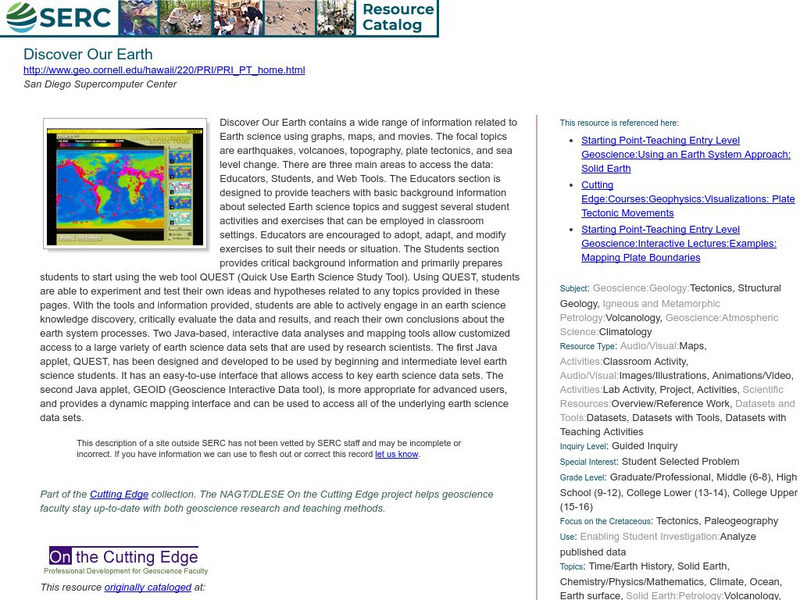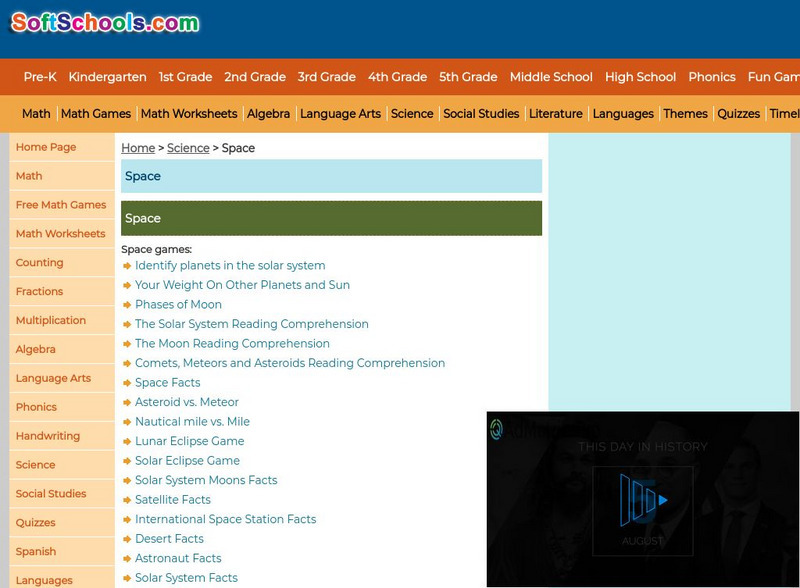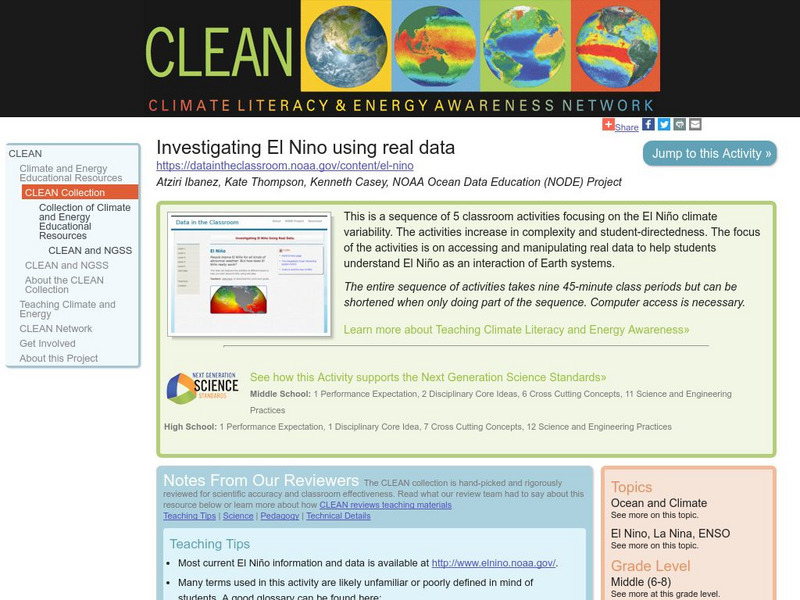Hi, what do you want to do?
Science Education Resource Center at Carleton College
Serc: Sea Ice Extension for the Earth as a System Learning Activity
The purpose of this lesson is for students to learn how the Earth's systems interact on a global level. They will examine global environmental data and compare this to data on the polar regions. In the process, they will develop an...
Science Education Resource Center at Carleton College
Serc: Exploring Earth Systems Science: The Interactive Globe Earth System Poster
In this introduction to Earth Systems Science, learners use images depicting global environmental data to explore connections and patterns in the climate system.
National Association of Geoscience Teachers
Nagt: Earth System Science Project
An Earth System Project shows the interaction between the Geosphere, Hydrosphere, Atmosphere, and Biosphere. This project provides a model of a pond ecosystem and can easily be woven into the hydrosphere unit.
Other
Digital Library for Earth System Education: Teaching Box: Essentials of Weather
A suite of lessons focusing on the basic elements of climate and weather. Inquiry-based exploration of extreme weather events and the factors of weather including clouds, wind, air pressure, temperature, and the water cycle.
PBS
Pbs: Earth Science Exploration
An earth science collection where young scholars can explore earthquakes, volcanoes, and more natural phenomena. The collection uses videos and interactive activities to investigate our dynamic planet and earth systems.
Science Education Resource Center at Carleton College
Serc: Discover Our Earth
Study earthquakes, volcanoes, topography, plate tectonics, and sea level change using graphs, maps, and movies. Engage in earth science knowledge discovery, critically evaluate the data and results, and reach conclusions about the earth...
Georgia Department of Education
Ga Virtual Learning: Ap Environmental Science: Science, Matter, Energy, Systems
Through interactive activities, reading exercises, and lab activities, students study how science, matter, energy, and systems are interrelated.
Soft Schools
Soft Schools: Space: Solar System Interactives
Identify the planets in our solar system and discover how much you weigh on another planet with these space interactives.
NOAA
Noaa: Earth System Research Laboratory: Psd: Interactive Climate Map of u.s.
Investigate climate trends across the United States by clicking on individual states and then specific cities. Data is presented from 1961-1990.
Texas Education Agency
Texas Gateway: The Sun Is the Center of the Solar System
See what you know about the solar system by taking this brief interactive quiz and learning module.
National Earth Science Teachers Association
Windows to the Universe: Our Solar System
Our solar system is filled with a wide assortment of celestial bodies - the Sun itself, our eight planets, dwarf planets, and asteroids - and on Earth, life itself! The inner solar system is occasionally visited by comets that loop in...
TeachEngineering
Teach Engineering: Projections and Coordinates: Turning a 3 D Earth Into Flatlands
Projections and coordinates are key advancements in the geographic sciences that allow us to better understand the nature of the Earth and how to describe location. These innovations in describing the Earth are the basis for everything...
Khan Academy
Khan Academy: Gallery: How Do Earth and Life Interact?
Explore the biosphere, zoom in on some unique ecosystems, and learn how activity in the Solar System and plate tectonics can affect the climate and life on the planet.
Georgia Department of Education
Ga Virtual Learning: Ap Biology: Ecology
Students review the study of living things and make connections back to Earth's systems. This unit focuses on how various species, grouped in populations and communities, work with the nonliving things around them to ensure survival.
A&E Television
History.com: The Space Race: Interactive Universe
A virtual journey through space offers photos and facts about Earth and its neighboring planets, comets, other celestial bodies of the Solar System, and the Milky Way and Andromeda galaxies.
Utah State Office of Education
Utah Science: Rocks & Minerals
A unit on rocks and minerals presented with interactive and classroom activities. Gain understanding of rocks, weather, erosion, earthquakes, and relative dating with this resource.
Georgia Department of Education
Ga Virtual Learning: Ap Environmental Science: Introduction
An introductory module with interactive activities, class notes, lab activities, and review questions which cover advanced placement environmental science concepts.
National Association of Geoscience Teachers
Serc: Modeling the Effects of Dam Removal on the Elwha River
Students are introduced to river systems and how they evolve and interact with the Earth's surface over time. They learn about the social and scientific issues surrounding the removal of the Glines Canyon Dam on the Elwha River and...
NASA
Nasa: Exploring Climate Change
Test your knowledge of energy and its role in Earth's climate system with these interactive quizzes.
Climate Literacy
Clean: Investigating El Nino Using Real Data
A sequence of five online activities focusing on the El Nino climate variability. The focus of the activities is on accessing and manipulating real data to help students understand El Nino as an interaction of Earth systems.
Scholastic
Scholastic: Diagramando a La Ciencia
Fun interactive Spanish site where students will be able to review science vocabulary related with the earth, atmosphere, respiratory system, flower parts and fish anatomy. It provides the English version and different levels of difficulty.
National Earth Science Teachers Association
Windows to the Universe
Windows to the Universe has developed an interactive resource about the earth, space, biological and physical sciences. Content includes information on our planet, the solar system, the universe, myths associated with space, space...
NASA
Nasa: Space Place: Messenger: Planet Mass Comparison
Compare the masses of planets in this interactive animation. Simply pile a number of Earths on one side of the scale, to balance with the mass of one Jupiter. Then try this with all the planets.
Other
University of Cambridge: Astro Adventure
Imagine a time when you can travel through space, planet to planet, cheaply and in comfort, when you can take a trip to the stars as your next holiday. Well, imagine no more. Learn more about the solar system as you take this trip of a...


























